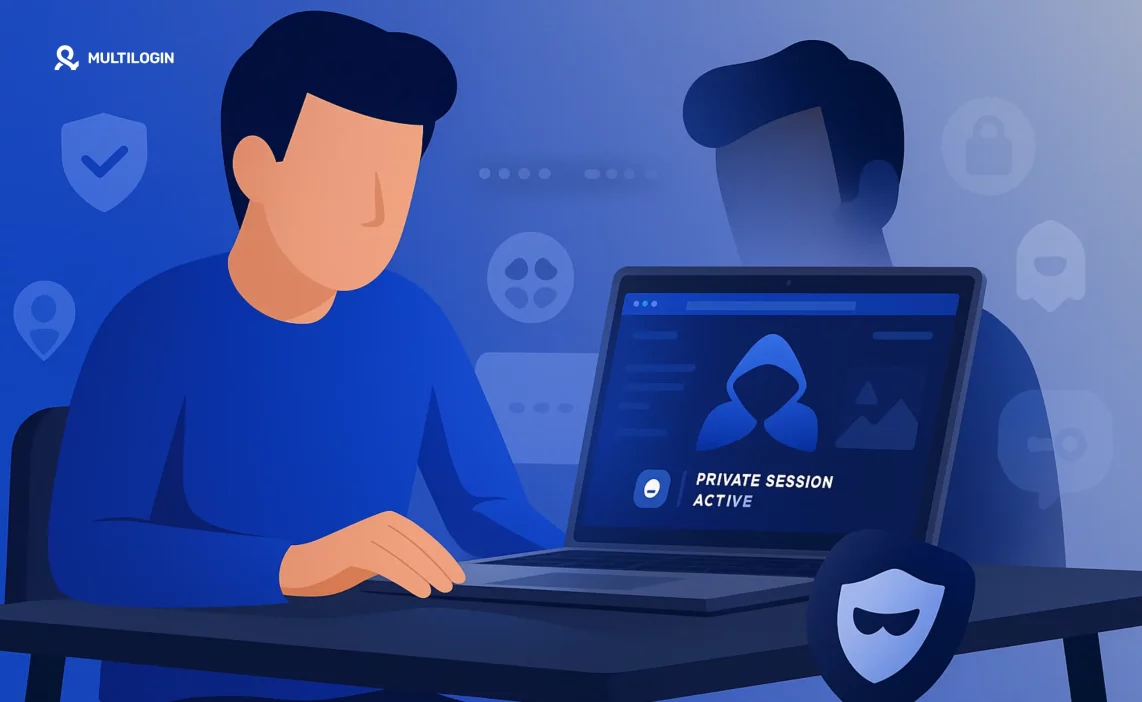Ever searched “how to browse anonymously” and still felt exposed? You’re not alone. In 2025, anonymous browsing isn’t just for the paranoid—it’s a must for anyone who values privacy, security, or, let’s face it, a little digital mischief.
Did you know over 70,000 people search for anonymous browsing every month? (That’s a lot of people who don’t want their secrets out.) Whether you’re researching, working remotely, avoiding ad trackers, or just want to keep your online activity off the radar, it’s never been more important to protect your digital footprint.
But here’s the problem: Most “browsing anonymous” guides give you outdated, surface-level tips. This guide cuts through the noise, showing you exactly how to stay completely anonymous online with 11 actionable, modern techniques—plus how to level up with tools like secure anonymous browsers and anti-detect solutions.
Ready to make online anonymous browsing your new superpower? Let’s go.
Why Is Anonymous Browsing So Important in 2025?
If you’ve ever wondered “what is anonymous browsing?” or searched for ways to keep your online activity private, you’re not alone. Anonymous internet browsing has gone from a niche curiosity to a mainstream necessity.
With over 70,000 people searching for anonymous browsing every month, it’s clear that concerns over privacy, tracking, data collection, and even geo-restrictions have hit home for almost everyone online.
Whether you’re a journalist needing to protect your sources, a business running confidential research, or just someone tired of being bombarded by ads, browsing anonymous isn’t just smart—it’s essential.
But as tracking methods get more sophisticated, only the right anonymous browsing techniques will actually keep you hidden in 2025.
Anonymous Browsing Techniques vs. Incognito: What Actually Works?
It’s easy to think incognito mode or a simple browser switch is all you need for online anonymous browsing—but that’s far from the truth. While private browsing modes do help keep your local history clean, they don’t offer real protection from browser fingerprinting, ad trackers, or prying eyes at your ISP.
To browse the internet anonymously and maintain true anonymity while browsing, you need more robust solutions—like secure anonymous browsers, anti detect browsers, privacy search engines, and VPNs.
Below, we’ll break down 11 proven anonymous browsing methods that actually work in 2025—so you can stay one step ahead of snoopers and enjoy real privacy online.
11 Legitimate Tips for Anonymous Browsing in 2025
1. Use a VPN for True Anonymous Internet Browsing
A Virtual Private Network (VPN) is still one of the most effective anonymous browsing techniques. A VPN encrypts your internet connection and routes your web activity through secure servers, hiding your real IP address and shielding you from trackers, hackers, and even your own ISP.
- Want to browse the internet anonymously from anywhere—even on public Wi-Fi?
- Need to access content restricted in your country, or keep your location hidden?
Pro Tip: Always choose a reputable, zero-log VPN for secure anonymous browsing—free online anonymous browsing tools often leak your data!
Extra Layer: Combine a VPN with a secure anonymous browser (like Multilogin) for ironclad privacy.
2. Switch to Tor Browser for Top-Tier Anonymity
Tor Browser takes anonymous internet browsing to another level by routing your traffic through a distributed network of volunteer-operated servers (“relays”). Every click is encrypted and bounced worldwide, making it extremely hard for anyone to track your browsing activity or link your IP to your identity.
- Ideal for activists, journalists, or anyone serious about private browsing.
- Tor is open-source, free, and built to keep you anonymous—even from sophisticated trackers.
Heads-up: Tor can be slow, and not all websites play nicely with it. Combine with a VPN or proxy browser for extra protection.
3. Use a Secure Anonymous Browser (Or Go Antidetect!)
Looking for the most secure way to browse anonymously, without worrying about browser fingerprinting or advanced tracking? Enter the secure anonymous browser—and, if you want ultimate stealth, the anti detect browser.
Why regular browsers won’t cut it: Even Chrome or Firefox in incognito mode still leak data via your browser fingerprint, plugins, fonts, and more. That’s where anti detect browsers like Multilogin come in:
- They spoof your browser fingerprint, device info, and even your geolocation.
- Built-in residential proxies (like those in Multilogin) route your traffic through real, clean IPs.
- Perfect for multiaccount management, ad verification, web scraping, or anyone who needs bulletproof anonymity.
4. Browse with Incognito Mode (But Know Its Limits!)
Incognito (or Private Browsing) mode is available in most web browsers and is great for keeping your local browsing history, cookies, and temporary files hidden. It prevents people who use your device from seeing your online activity.
But don’t be fooled:
Incognito doesn’t hide your IP address, prevent browser fingerprinting, or protect you from trackers and ISPs. For truly anonymous website browsing, combine incognito with other methods (VPN, secure browsers, or proxies).
5. Always Use HTTPS for Secure Anonymous Surfing
If you want to make your anonymous internet surfing bulletproof, look for the lock icon and “https://” in the address bar. HTTPS encrypts the data sent between your browser and the website, protecting you from hackers, snoops, and man-in-the-middle attacks—even on public Wi-Fi.
Tip:
Most anonymous browsing websites use HTTPS by default, but if you ever get a warning, don’t ignore it. No HTTPS = no secure browsing!
6. Ditch Google: Use Privacy Search Engines
Tired of your every search being tracked and sold? Switch to a privacy search engine like DuckDuckGo, Startpage, or MetaGer. These search tools don’t log your queries or tie your searches to your personal information.
Bonus:
Some anonymous browsing websites embed privacy search engine features right on the homepage—perfect for quick, safe searches.
7. Deploy Virtual Machines for High-Stakes Anonymous Browsing
Want to go full “spy mode”? Use a virtual machine (VM) for your anonymous internet browsing. A VM lets you run a separate, disposable operating system inside your regular computer, isolating all web activity.
- Test suspicious sites, visit dark web addresses, or run privacy tools risk-free.
- After browsing, simply delete the VM—no trace left behind.
8. Be Wary with Public Wi-Fi—And Always Use Protection
Free Wi-Fi is a hacker’s playground. Always treat public hotspots as dangerous when it comes to anonymous browsing online free. Never log in to sensitive accounts or browse confidential sites unless you’re protected by a VPN or secure proxy browser.
Remember:
Anyone on the same network could be sniffing your data!
9. Clear Cookies and Cache (Don’t Let Trackers Build a Profile)
Websites use cookies and cache to identify your device, store preferences, and build detailed profiles on your online activity.
For maximum anonymity:
- Clear your cookies and cache after each session (most browsers make this easy).
- Use browser extensions like Cookie AutoDelete, or switch to browsers with built-in privacy controls.
- Pro tip: Some anti detect browsers do this automatically for you.
10. Enable Two-Factor Authentication for Secure Anonymous Accounts
If you’re managing accounts, especially multiple ones, two-factor authentication (2FA) is a must—even for anonymous browsing accounts. 2FA requires a second verification (like an SMS code or authenticator app), making it nearly impossible for attackers to break in with just a password.
Anonymity hack:
Create email aliases or use burner phone numbers for 2FA setup. Don’t let account recovery become a privacy leak!
11. Use an Antidetect Browser for Ultimate Online Anonymity
Traditional browsers—even in incognito—leave a digital fingerprint. Antidetect browsers (like Multilogin) take privacy to a whole new level:
- They rotate or spoof browser fingerprints, device specs, and even network info.
- Integrate proxy management and automation for true multiaccount management.
- Beat trackers, anti-fraud systems, and geo-blocks at their own game.
Why Multilogin?
It’s the leading anti detect browser for browsing anonymous, secure, and hassle-free in 2025. Competitors like Incogniton and GoLogin offer some features, but Multilogin’s combination of built-in residential proxies, automation tools, and ironclad privacy makes it the best alternative to using just a proxy or VPN.
Ready to experience true anonymous browsing?
Frequently Asked Questions About Anonymous Browsing
The most secure anonymous browsing method combines a reputable anti detect browser (like Multilogin), a zero-log VPN, and a privacy-focused search engine.
Yes, with tools like Tor and privacy search engines. But for full anonymity, especially if you need speed and multiaccount management, a paid anti detect browser like Multilogin is the smart choice.
No—incognito mode only hides your browsing history locally. To maintain true anonymity while browsing, use it with VPNs, secure browsers, and privacy search engines.
These are sites or tools designed for online anonymous browsing, often with built-in privacy features, HTTPS, and no-logs policies.
Use a secure, privacy-focused email provider, access with an anti detect browser, and always hide your IP and personal data.
Why Settle for Half-Measures? Make Anonymous Browsing Effortless
Anonymous browsing in 2025 isn’t about hiding from the world—it’s about taking control of your online identity. The right tools let you work, explore, and play without being watched, profiled, or limited by geography or trackers.
If you’re serious about online privacy, don’t just stop at VPNs or incognito mode—level up with a secure anti detect browser like Multilogin.


